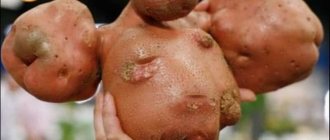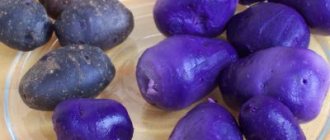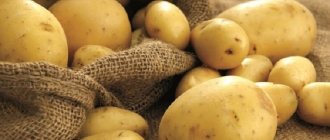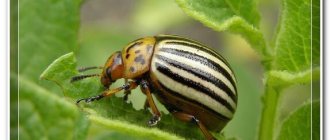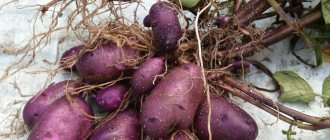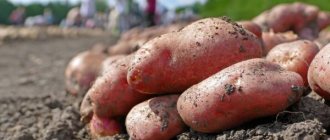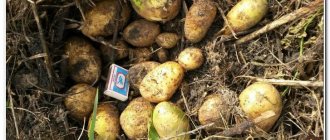Author's rating
Author of the article
Yakov Pavlovich
Professor, Head of the Department of Vegetable Growing
Articles written
153
Purple colored potatoes are still perceived by most Russian residents as an exotic vegetable. Despite its unusual appearance, it has the same taste as the standard variety. But at the same time, it has characteristic features that positively distinguish it from its white “brothers.”
Description of the variety
Purple potatoes have a delicate, nutty flavor and are distinguished by interesting tuber colors: from pale lilac to bright purple. It is especially valued for its beneficial properties and chemical composition.
Origin and development
The lilac-colored peel and pulp are not related to genetic engineering. Presumably colored potatoes originated in South America, then they became widely used in many countries around the world.
Reference! About 120 intermediate potato samples are involved in the development of breeders, which will make it possible to obtain new varieties and hybrids in the future.
Culture appeared in Russia relatively recently. Scientists are working to improve potato keeping quality and disease resistance.
Varieties of varieties
There are several varieties of purple potatoes of foreign and domestic selection. Some have an unusual color only on the skin, others are purple and purple inside.
Blue Danube
This mid-early variety of English selection is resistant to diseases, mechanical damage and drought. It has a dense peel of a lilac-violet hue. The yield of Blue Danube potatoes is about 350 c/ha. The white pulp is tasty and does not become overcooked. Used for soups, salads and frying.
Gypsy
The variety is mid-early, does not tolerate drought well, is resistant to cancer, gray rot, and scab. The flesh is yellowish and tender. The tubers have thin skins, so it is recommended to dig them up by hand. Productivity is 200–250 c/ha, from 6 to 14 potatoes are produced in one bush.
All Blue
The name of the variety of this purple potato means “All Blue” in English. The tubers have an interesting color: the peel and the middle of the pulp are dark blue, and the top layer is light blue. If you cut a potato, a light ring is clearly visible on the cut. During heat treatment, the color of the pulp is preserved.
The oval tubers are large: some weigh up to 200 g. The harvest does not last long, about 3 months, and germinates quickly.
Lilac
Russian mid-season variety. Tubers are medium in size, yield is 150–180 kg per hundred square meters. The potato flesh is lilac with a slight almond flavor. Good for salads.
Miracle Man
The mid-season potato Chudesnik was created at the Ural Research Institute of Agriculture. The peel and pulp are violet-amethyst, the taste is more delicate than that of ordinary tubers. Vegetables are rich in vitamin C.
The culture is resistant to fungal diseases and unfavorable climatic conditions. Productivity is low: 100–180 c/ha.
Adirondack Blue
Mid-season potatoes of American selection. Productivity reaches 400 kg per hundred square meters of land. The crop is susceptible to scab and late blight. The harvest is poorly stored; already in the middle of winter it begins to germinate and becomes soft. The pulp is inky in color, does not boil well, is more suitable for frying.
Miami
A mid-early variety, resistant to late blight, suitable for growing in the Moscow region, Siberia, and the Urals. Productivity - 350–400 c/ha. The peel and pulp of large tubers (weigh up to 110 g) are blue-violet. Miami potatoes have a sweetish taste; the vegetable is suitable for mashing.
Vitelot (French truffle)
A late variety, the tubers produce small ones (no more than 10 cm in length). Under the bush, 6-8 vegetables are formed, weighing 60-75, less often - up to 100 g. Gardeners note low yields: even under favorable conditions, no more than 200 kg are harvested from 1 hectare of land.
Reference! Alexandre Dumas especially liked this variety.
Truffle potatoes have a pleasant nutty taste and have good shelf life due to their thick skin. It is considered a gourmet variety. The dark purple pulp contains a lot of anthocyanins and starch. Suitable for purees.
Purple Peruvian (Peruvian purple)
Medium-yielding and fairly late variety. The mass of the tuber is about 80 g; about 180 kg of potatoes are harvested from one hundred square meters of land. The pulp has a pronounced hazelnut flavor, so it is often added to salads, even raw. The vegetable is purple outside and inside.
Chemical composition
All purple potato varieties contain:
- anthocyanins;
- calcium and potassium;
- phenolic acids;
- vitamins B1, B2, B5, B6, A, C, E;
- carotenoids.
Tubers contain 12-13% starch, which is significantly lower than that of their white-yellow counterparts. Therefore, this unusual vegetable is classified as a dietary product.
Ripening period
Typically, 60–90 days pass from the appearance of the first shoots to full ripening. These values vary depending on the variety.
Productivity
Most varieties of purple potatoes have high yields: up to 400 kg per 1 hectare of land. The exceptions are the Lilac, Vitelot and Peruvian Violet varieties. Their yield does not exceed 200 kg per 1 hectare.
Disease resistance
Lilac-purple potatoes are less resistant to diseases and pests than regular potatoes.
Main diseases:
- late blight;
- scab;
- bacterial cancer;
- all types of rot.
Characteristics of tubers
Depending on the variety, the pulp is white, yellow or inky in color, and the peel is always colored and quite dense. The weight of oblong tubers varies from 60 to 150 g.
Climate requirements
Potatoes with colored pulp are not yet grown on an industrial scale in the CIS. However, summer residents who are ready to experiment are equally successful in cultivating this vegetable in all regions of Russia, except Siberia and the Far East: due to the harsh climate, the crop grows poorly. Some varieties (Miami, Chudesnik) are more resistant to adverse weather conditions.
Useful properties and characteristics of purple or blue potatoes
Not long ago, an exotic vegetable appeared on store shelves - purple potatoes. At first, consumers were wary of it, but when the beneficial properties became known, the situation immediately changed. Besides the exotic color of the pulp allows chefs to create culinary masterpieces, characterized by an original appearance. True, this type of potato is not yet grown on an industrial scale in our country, but for your own summer cottage you can easily order seed from an online store.
Advantages and disadvantages of the variety
The main advantages of purple potatoes are their nutritional value and rich composition. The main disadvantages are susceptibility to disease and poor shelf life.
Features of purple-colored potatoes:
- tubers and pulp of unusual color, nutty taste;
- the culture is more capricious in care and is stored worse;
- Potatoes remain colored even after heat treatment.
Beneficial features
Purple potatoes contain potassium, which contributes to the smooth functioning of the cardiovascular system. Anthocyanins and polyphenols have antioxidant activity and inhibit the aging of the body.
Ascorbic acid helps strengthen the immune system, vitamin E helps maintain water balance and beauty of the skin, and B vitamins strengthen the nervous system. Carotenoids are indispensable for the full functioning of the human endocrine system, calcium is important for the skeletal system.
Dietary fiber improves the functioning of the digestive system. Due to its low starch content, the vegetable is approved for feeding people with diabetes.
Cooking
Today, due to its insignificant distribution, this species is considered a delicacy. Long-term heat treatment (cooking, stewing, frying in oil) almost does not change the color of the finished vegetable. The high starch content in the pulp is the reason that potatoes boil well. The menus of many famous restaurants around the world often include lilac, purple or lavender-colored purees.
Calorie content: 72 kcal. Used - 2.0/0.4/16.0 g per 100 g of product.
The vegetable has a rich nutty, sometimes ginger-like taste. Most often it is pureed, served fried, steamed or baked. True gourmets and lovers of aesthetics will definitely enjoy chips or potato pancakes.
To deepen the color, boil in slightly salted water for 20 minutes.
Contraindications for consumption:
- hypotension;
- individual intolerance;
- allergic reactions.
Related article:
5 best potato varieties for planting in June that are guaranteed to yield a good harvest
Features of planting and growing
When cultivating this vegetable, it is recommended to take into account some nuances. The culture is demanding to care for and requires patience and certain skills.
Preparing for landing
Tubers begin to be prepared 1.5 months before planting. They are transferred from storage to a warmer place and laid out in one layer.
Important! The ideal temperature for tuber germination is +10…+12°C. To speed up the appearance of sprouts, the seeds are periodically sprayed with water.
When the sprouts reach 2 cm, the potatoes are brought out into the light so that the sprouts do not stretch too much.
Soil requirements
The yield and taste of vegetables depend on the composition of the soil. The most unsuitable soil for purple potatoes is loam, the most favorable is light and fertile, saturated with air. The vegetable does not tolerate drought well, but stagnation of water must also be avoided.
Before planting, the soil is dug up twice: in the fall, before the first frost, and in the spring, immediately before planting. If the soil is too hard, add river sand.
Dates, scheme and rules of planting
The vegetable is planted in the spring, when the soil warms up to +5...+7°C, since the plant does not tolerate late spring frosts.
Holes about 10 cm deep are made in the dug up soil, and wood ash is added for disinfection. The holes are made according to a 35x60 cm pattern to provide enough space for rooting and formation of bushes. Potatoes are planted in the prepared holes using one of the selected methods.
Features of cultivation
Growing purple potatoes is no different from cultivating regular varieties.
There are two planting methods:
- traditional eyed;
- seedling
With the eye method, the prepared seed material is buried in the holes, sprinkled with wood ash. The first shoots usually appear 10–14 days after planting.
In the second option, the seeds are sown at home for seedlings. After this, the finished sprouts are transferred to a permanent place. Replanting begins in May, when the soil warms up to +5...+7°C.
Nuances of care
To successfully cultivate purple potatoes and obtain a rich harvest, you need to feed the plants, water and weed in a timely manner.
Watering mode
Caring for plants involves constant monitoring of soil moisture. If there has been no precipitation for 10–15 days, the seedlings are watered with warm water. Irrigation is especially important during budding and after flowering. It is necessary to avoid stagnation of water in the soil.
When an earthen crust forms, it is thoroughly loosened.
Top dressing
Purple potato varieties require periodic feeding: during budding and after flowering. Organic and potassium fertilizers are used. Before planting, it is advisable to add humus at the rate of 0.5 kg per 1 m2.
Weeding and hilling
The first hilling is carried out after the appearance of friendly shoots. This will protect young bushes from return frosts and retain moisture. The procedure is repeated when the plants reach a height of 30–35 cm.
Weeding is carried out several times during the summer as needed.
Disease and pest control
Many varieties are resistant to major potato diseases, but precautions are never superfluous.
Attention! Before planting, the seeds are treated with a fungicide and treated with potassium permanganate. This will protect the plants from late blight and some pests.
It is important to change the planting location, alternating crops on the site with legumes and cruciferous vegetables.
For potato diseases, Bordeaux mixture, copper sulfate, Kuprikol, Kurzat R (preparations based on copper salts), Ditan M-45 (active ingredient - mancozeb), Shirlan, Thanos are used.
Colorado beetles and click beetles are the main enemies of the crop. They spoil the tops and appearance of tubers, reduce productivity and negatively affect the shelf life of vegetables. Pests are eliminated using insecticides.
What are the benefits of purple potatoes?
Despite its “exotic” appearance, such potatoes are characterized by the presence of many substances necessary and important for human health.
Thus, this potato contains:
- Water (about 80%);
- Vegetable proteins;
- Fats;
- Fatty acids represented by myristic, palmitic, stearic, linoleic, oleic (omega-9), palmitoleic, linolenic and omega-6;
- Carbohydrates (including digestible ones - dextrin, starch, sugars, mono- and disaccharides, fructose, sucrose, glucose or dextrose);
- Essential amino acids (valine, arginine, histidine, leucine, isoleucine, methionine, lysine, tryptophan, threonine, tyrosine, phenylalanine);
- Replaceable amino acids (aspartic and glutamic acids, alanine, glycine, tyrosine, proline, serine, ustein);
- Organic acids;
- Dietary fiber (fiber);
- Ash products;
- Retinol (or vitamin A);
- Provitamin A (beta-carotene);
- Vitamins from series B (thiamine, riboflavin, pyridoxine, pantothenic and folic acids, niacin);
- Phylloquinone (vitamin K);
- Ascorbic acid (vitamin C);
- Alpha tocopherol (vitamin E);
- Vitamin N (biotin);
- Macroelements in the form of calcium, potassium, magnesium, sodium, phosphorus, sulfur and chlorine;
- Minerals represented by boron, iron, aluminum, lithium, cobalt, iodine, copper, manganese, molybdenum, nickel, fluorine, rubidium, selenium, zinc and chromium.
The total calorie content of 100 grams of purple potatoes is 72 kilocalories. As for its nutritional value, 100 grams contains:
15 grams of carbohydrates;
1 gram of fiber;
Harvest and storage
The conditions for collecting and storing purple potatoes largely depend on the varietal characteristics.
How and when to collect
Some varieties of tubers have quite thick skin; vegetables are harvested using special equipment or a walk-behind tractor:
- Witelot;
- Blue Danube;
- Peruvian purple.
It is better to dig up more tender tubers by hand with a shovel or pitchfork. These varieties include:
- All Blue;
- Gypsy;
- Lilac;
- Adirondack Blue;
- Miracle Man;
- Miami.
Otherwise, the harvesting technique is the same as with regular potatoes. After ripening, the bushes are pre-pruned, leaving the stems at a height of 10–12 cm.
Tubers are dug up only in dry weather. Vegetables are dried in the sun or under a canopy.
Storage features and shelf life
Most varieties cannot withstand long-term storage. For this reason, summer residents allocate a small plot of land for the delicious vegetable.
Keep the harvest at a temperature of +2...+3°C, in a place protected from sunlight.
The Vitelot, Peruvian Violet, and Blue Danube varieties have good shelf life (4–6 months). The rest are stored for no more than 3 months.
History of origin
The purple potato, also called the black potato, the Chinese truffle potato, or the lilac French truffle potato, originated without any genetic intervention in South America in a small community in the Andes Mountains.
At first ignored by breeders, it was still known in European countries in the 19th century - there are mentions of potatoes in an agricultural reference book from 1817.
After the benefits were proven, many people began to offer large sums for the opportunity to buy such an exotic product. In this regard, breeders began to actively create varieties with a characteristic color and improved performance by crossing purple potatoes with familiar species.
In Russia, this vegetable remained unknown until the 21st century and is still not popular. It gained recognition and distribution in 2007 at the international potato congress. Next, Russian scientists began to create varieties suitable for cultivation in the climatic conditions of Russia.
Advice from experienced gardeners and reviews
Summer residents like the unusual color of vegetables, the taste, and the yield of the crop.
Serafima, Stary Oskol : “Last year we planted Vitelot in our dacha. The tubers turned out interesting and attractive. The grandchildren liked the unusual color, and my husband appreciated the nutty taste.”
Sergey, pos. Otradovka: “My wife likes to experiment, and so she suggested planting purple potatoes in the garden. I ordered the Lilac variety. We planted about half a acre and got one and a half bags of potatoes. I watered it twice over the summer. Overall I liked it, it was delicious. I will plant more."
This is interesting:
High-yielding purple potato variety “Cornflower” from domestic breeders
Mid-early table potato variety Gourmet purple
Classification of potatoes by type
Purple potatoes
Purple potatoes are a variety of potatoes with purple skin and flesh. They have a medium starchy texture and a milder, nuttier flavor than regular white potatoes. As scientists have found, such potatoes contain more antioxidant compounds that regular potatoes cannot compete with.
As you know, the essence of even an unusual vegetable does not actually change. Therefore, you don’t even need to avoid purple potatoes. After all, it will bring a non-standard look to familiar dishes, fill them with original taste and, in addition, leave a positive mark on human health. For example, it has been found to help lower blood pressure, accelerate weight loss, and prevent depression.
These potatoes can be fried, boiled, baked, mashed, added to soups and other dishes. Let's take a closer look at such an unusual potato and find out how it is useful for the human body, what beneficial properties it has and whether there are contraindications to its use.
